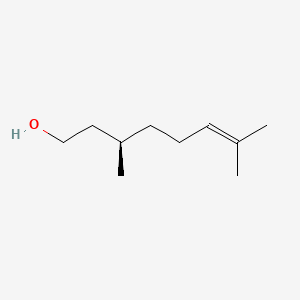| Authors | Title | Published | Journal | PubMed Link |
|---|---|---|---|---|
| Nidiry ES | Quantitative structure-fungitoxicity relationships of some monohydric alcohols. | 2003 | J. Agric. Food Chem. | pmid:12926880 |
| pmid:12929969 | ||||
| pmid:12946413 | ||||
| Heth G et al. | Differential olfactory perception of enantiomeric compounds by blind subterranean mole rats (Spalax ehrenbergi). | 1992 | Experientia | pmid:1397188 |
| Vanek T et al. | Biotransformation of citronellal by Solanum aviculare suspension cultures: preparation of p-menthane-3,8-diols and determination of their absolute configurations. | 2003 | J. Nat. Prod. | pmid:14510606 |
| Mori K | Synthesis of the enantiomers of 21-methyl-7-hentriacontanone and a stereoisomeric mixture of 5-acetoxy-19-methylnonacosane, candidates for the female sex pheromone of the screwworm fly Cochliomyia hominivorax. | 2003 | Biosci. Biotechnol. Biochem. | pmid:14586112 |
| pmid:14640588 | ||||
| Gil J et al. | Cytosolic and mitochondrial ROS in staurosporine-induced retinal cell apoptosis. | 2003 | Free Radic. Biol. Med. | pmid:14642398 |
| Cal K and Sznitowska M | Cutaneous absorption and elimination of three acyclic terpenes--in vitro studies. | 2003 | J Control Release | pmid:14644586 |
| pmid:14664823 | ||||
| Abe S et al. | Suppression of tumor necrosis factor-alpha-induced neutrophil adherence responses by essential oils. | 2003 | Mediators Inflamm. | pmid:14668091 |
| Kalyvas A and David S | Cytosolic phospholipase A2 plays a key role in the pathogenesis of multiple sclerosis-like disease. | 2004 | Neuron | pmid:14766173 |
| Demyttenaere JC et al. | Biotransformation of (R)-(+)- and (S)-(-)-citronellol by Aspergillus sp. and Penicillium sp., and the use of solid-phase microextraction for screening. | 2004 | J Chromatogr A | pmid:14971495 |
| pmid:14971725 | ||||
| Luxová A et al. | Absolute configuration of chiral terpenes in marking pheromones of bumblebees and cuckoo bumblebees. | 2004 | Chirality | pmid:15034905 |
| pmid:15036874 | ||||
| pmid:15054660 | ||||
| Mikkola JP et al. | Utilisation of on-line acoustic irradiation as a means to counter-effect catalyst deactivation in heterogeneous catalysis. | 2004 | Ultrason Sonochem | pmid:15081987 |
| pmid:15093616 | ||||
| Ottino P et al. | Hypoxia activates matrix metalloproteinase expression and the VEGF system in monkey choroid-retinal endothelial cells: Involvement of cytosolic phospholipase A2 activity. | 2004 | Mol. Vis. | pmid:15162095 |
beta-Citronellol
Beta-citronellol is a lipid of Prenol Lipids (PR) class. The involved functions are known as Glycolysis.
Cross Reference
Introduction
To understand associated biological information of beta-Citronellol, we collected biological information of abnormalities, associated pathways, cellular/molecular locations, biological functions, related genes/proteins, lipids and common seen animal/experimental models with organized paragraphs from literatures.
What diseases are associated with beta-Citronellol?
There are no associated biomedical information in the current reference collection.
No disease MeSH terms mapped to the current reference collection.
PubChem Associated disorders and diseases
What pathways are associated with beta-Citronellol
There are no associated biomedical information in the current reference collection.
PubChem Biomolecular Interactions and Pathways
Link to PubChem Biomolecular Interactions and PathwaysWhat cellular locations are associated with beta-Citronellol?
There are no associated biomedical information in the current reference collection.
What functions are associated with beta-Citronellol?
Related references are published most in these journals:
| Function | Cross reference | Weighted score | Related literatures |
|---|
What lipids are associated with beta-Citronellol?
There are no associated biomedical information in the current reference collection.
What genes are associated with beta-Citronellol?
There are no associated biomedical information in the current reference collection.
What common seen animal models are associated with beta-Citronellol?
There are no associated biomedical information in the current reference collection.
